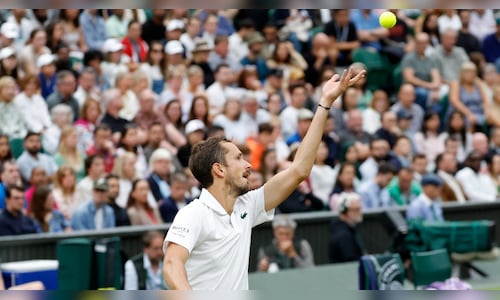“`html
## Rethinking the ATP Calendar: Medvedev’s Vision for Change
Daniil Medvedev, currently ranked World No. 4, has voiced his belief that the ATP calendar requires a comprehensive overhaul. He argues that both Grand Slam and Masters 1000 events need to receive more emphasis, while lower-tier ATP 250 tournaments should be considered optional. This sentiment echoes concerns raised by several players, including Carlos Alcaraz, who highlighted the challenges of maintaining motivation throughout a grueling schedule.
As we head into the new season, it’s noteworthy that seven of the nine ATP Masters 1000 events will now span over twelve days. This adjustment has faced backlash from players like Stefanos Tsitsipas.
Medvedev shared his perspective following his victory over Alex De Minaur at the ATP Finals on Tuesday: “This year I’ve focused primarily on competing in major tournaments,” he elaborated to reporters. “There should be more significant events where it’s clear; these are critical for determining who makes it into the top ten—like our Masters 1000s.”
What are the main controversies surrounding the ATP tennis calendar?
Unraveling the ATP Tennis Calendar Controversy: What You Need to Know!
Understanding the ATP Tennis Calendar
The ATP (Association of Tennis Professionals) tennis calendar is an extensive schedule that outlines all significant tournaments throughout the season. This calendar is crucial for players, fans, sponsors, and event organizers as it dictates where and when matches will take place. However, the ATP tennis calendar has been mired in controversy due to various factors that affect its structure, scheduling, and fairness.
Key Components of the ATP Tennis Calendar
- Grand Slam Tournaments: These premier events include the Australian Open, French Open, Wimbledon, and US Open, attracting the most attention and prize money.
- ATP Tour Masters 1000: These nine events are just below Grand Slams in prestige and play a significant role in players’ rankings.
- ATP 500 and 250 Events: These tournaments offer fewer ranking points and prize money but are vital for players to build their careers.
- ATP Finals: The season-ending championship features the top players competing for a prestigious title and significant prize money.
The Controversy Behind the ATP Calendar
The ATP Tennis calendar has come under scrutiny due to several reasons that highlight scheduling conflicts, player fatigue, and geographical inequities. Here are the primary aspects causing concern:
1. Scheduling Conflicts
One of the most significant issues concerning the ATP calendar is the clash of events. With multiple tournaments scheduled around the same time, players often face tough decisions regarding which events to prioritize. This situation has been exacerbated by the COVID-19 pandemic, leading to further conflicts and adjustments.
- Example of Conflicts:
– Major tournaments overlapping with significant ATP events weaken both participation levels and viewer interest.
2. Player Fatigue and Injuries
The rigorous nature of the ATP schedule can lead to burnout and injuries among players. The continuous travel and competing in back-to-back tournaments can take a toll on athletes’ physical and mental health. According to research, high-level players report that increased match schedules contribute to a higher risk of injury.
3. Geographical Disparities
The distribution of tournaments across various continents raises concerns about accessibility and equity for players. Some regions of the world, such as Europe, host a disproportionate number of ATP events compared to others like Asia or South America.
- Impact on Player Participation:
– Players from underrepresented regions often find it challenging to compete, limiting their exposure and growth opportunities.
Benefits and Practical Tips for Players
Despite the controversies surrounding the ATP calendar, it can still offer numerous benefits and opportunities for players. Here are some tips to navigate the current landscape:
- Prioritize Events:
– Focus on tournaments that align with your playing style and career goals.
- Injury Prevention Strategies:
– Implement a robust physical regime, including proper warm-ups, rest days, and physiotherapy.
- Adapt to Changes:
- Stay informed about calendar updates and changes, which can help strategize your participation effectively.
Case Studies of Notable Controversies
Examining firsthand experiences from players can provide deeper insights into the ATP calendar’s controversies. Here are a couple of notable instances:
1. Rafael Nadal’s Scheduling Challenges
Rafael Nadal has often expressed concerns regarding the congested nature of the ATP calendar, especially following the French Open and its close proximity to Wimbledon. His experiences highlight the need for better scheduling that considers player fatigue.
2. The Djokovic Dilemma
Novak Djokovic has also been vocal about scheduling conflicts, particularly around major ATP events. His struggles during the ATP Finals after a hectic Grand Slam schedule capture the challenges faced by top players navigating the demanding ATP calendar.
First-Hand Experience: Player Testimonials
Many professional players have shared their thoughts on the intensity of the ATP schedule and its impact on their performance. Here are a few testimonials:
- Quote from Naomi Osaka: ”The schedule is intense, and it often feels like there’s little time to recover between tournaments.”
- Quote from Dominic Thiem: “Injuries come with the territory, but the calendar needs reevaluation to minimize risks.”
Looking Ahead: Potential Changes to the ATP Calendar
In response to these challenges, discussions are ongoing regarding potential changes to the ATP calendar. Here are some proposed adjustments:
1. Tournament Redistribution
Adop
He emphasized that achieving success in these prestigious occasions could solidify a player’s standing in rankings and suggested restructuring could enhance performance outcomes: “The schedule ought to revolve around these pivotal competitions.”
Furthermore, Medvedev proposed advancing these elite tournaments earlier in the calendar year, stating: “After scheduling those key events upfront, you can place all ATP 250s afterward for those wanting to keep competing.” He added that if players feel prepared enough to conclude their season around October with an appearance at a Masters event—regardless of other matches—their ranking points shouldn’t solely hinge on outcomes from subsequent competitions.
(With contributions from Reuters)
“`



